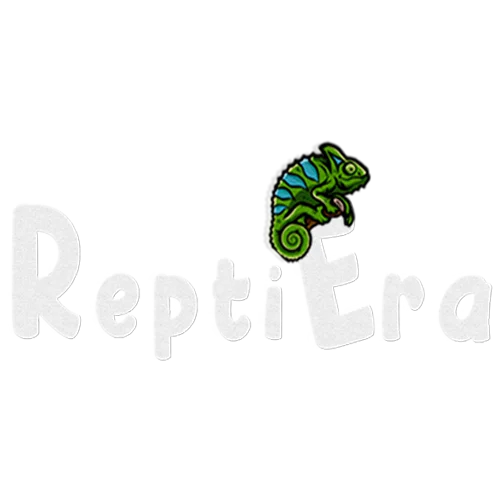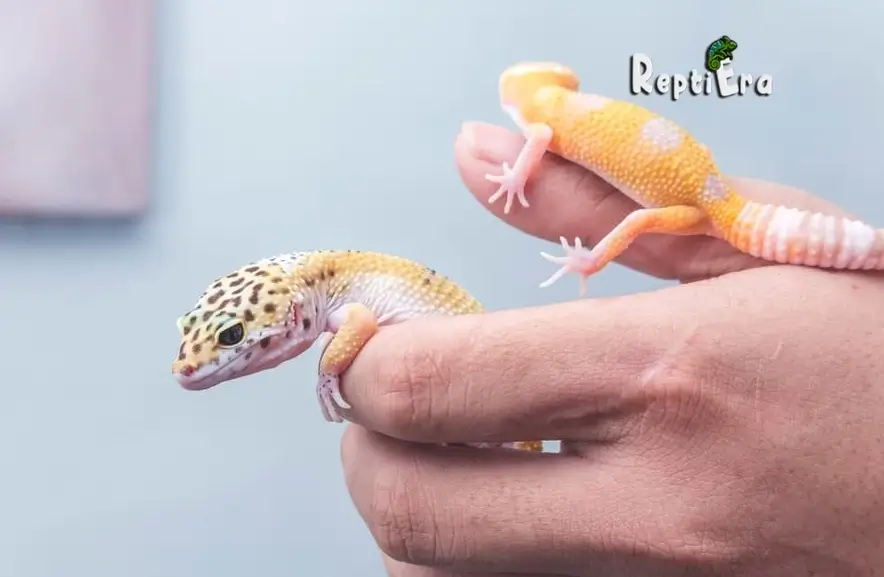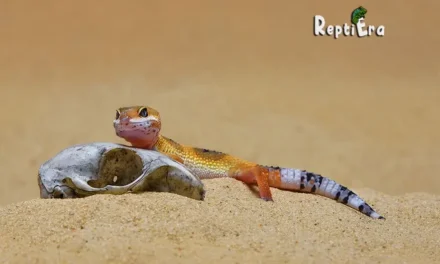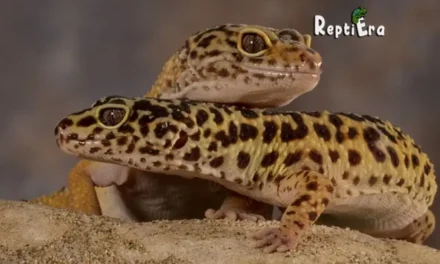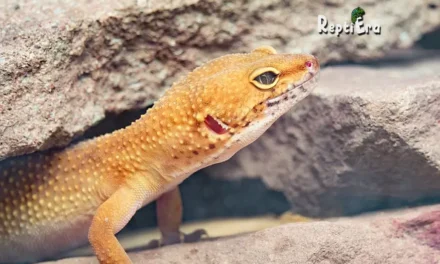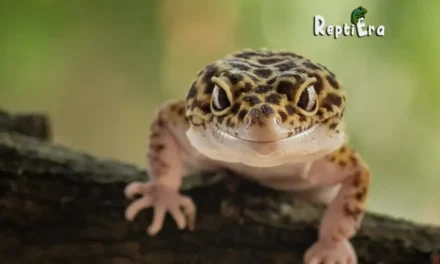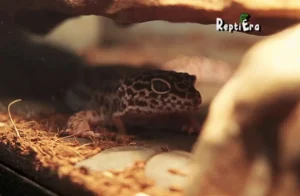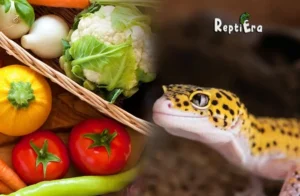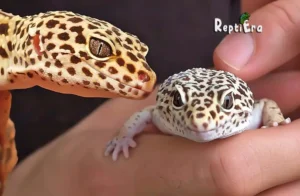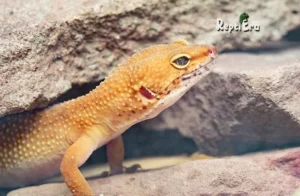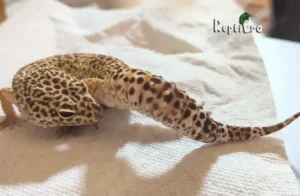Drawing from my personal experience with reptiles, I’ve learned that keeping a leopard gecko in a shared environment requires thoughtful consideration.
What Can Live With A Leopard Gecko?
While most people assume various animals can cohabit peacefully with these geckos, the truth is somewhat different. Frogs and turtles, for instance, are often touted as compatible roommates. However, they have distinct needs that make them less than ideal. Frogs, requiring a more humid environment, can’t thrive in the same arid conditions favoured by leopard geckos.
Similarly, turtles demand a more aquatic setup, which is far from the natural and dry habitat of the leopard gecko. It’s essential to consider the specific needs of each pet to ensure a fulfilling and stress-free life for them. When thinking about what to add to your leopard gecko’s tank, it’s best to stick with a few additional decorations that mimic their natural habitat, rather than introducing other animals. Remember, the goal is to create an environment where your leopard gecko can live comfortably, without the stress of incompatible tank mates.
Table of Contents
Can Leopard Geckos Cohabitate?
New reptile keepers often love their leopard gecko so much they consider adding more than one to their enclosure. They are indeed cute and fun to keep, but when it comes to whether leopard geckos can live together, the answer is yes, but it depends greatly on the gender.
A mixed-gender pair is risky, whereas all females or two males should not be housed together as they can be aggressive, leading to fights and lasting damage. In some instances, they may even fight to the death. When considering housing two males or a male and female together, you’re facing risks related to resources, space, and potential stress on the animals.
Female leopard geckos can often live together, especially under the care of an experienced owner. When you purchase from pet stores or breeders, it’s crucial to select ones that are roughly the same size to avoid a size differential where one could bully the other. There’s also the possibility of ending up with babies if you house a male with a female. Even in one male with multiple female arrangements, the risk of laying fertile eggs can lead to stress, health issues like weight loss or calcium deficiency, and complications from breeding.
When purchasing reptiles, knowing their sex is vital; telling the difference requires a reputable breeder who can point out the bulges behind the vent, tail, or a row of pre-anal pores. This task can be challenging to spot with an inexperienced eye.
Also Read: WHY DOES MY LEOPARD GECKO LICK ME
Other Reptiles that can live with a leopard gecko
In the realm of reptiles, finding suitable tank mates for leopard geckos is a nuanced task. While some lizards can coexist harmoniously, it’s vital to avoid bearded dragons due to their aggressive nature, ensuring a serene environment for your gecko.
1. Turtles
When considering tank mates for your leopard gecko, turtles can be a different yet great choice. It’s essential to ensure that the tank is properly set up to comfortably accommodate both animals. For instance, a large tank is advisable, as turtles tend to take up more space than the usual reptile pets. Creating hiding spots where your leopard gecko can retreat when they feel threatened or tired is vital.
Remember, these adorable creatures, especially the cutie leopard geckos, need time to get on well with their new tank companions. Set up the environment in a way that allows both pets to express themselves naturally. In my experience, this careful arrangement makes them feel secure and less likely to feel threatened.
In exploring partnerships for leopard geckos, turtles stand out as a stress-free and beautiful choice. Keep in mind, that the habitat needs a spray of water on the walls of the tanks to mimic a natural environment. Turtles, usually calm and friendly, won’t attack your gecko’s space. However, it’s essential to be wary when you house them with other types of pets. While turtles are safe, fish or frogs can be dangerous to your leopard geckos.
All things considered, this cohabitation requires effort to take care of both species properly, ensuring a harmonious living space for your diverse pet family.
2. Frogs
When considering frogs as companions for leopard geckos, it’s crucial to ensure you select the right types. Don’t rush; take time researching the different types of frogs available in your area for the best results. You might opt for species like Mantella or poison dart frogs; the latter are usually toxic in the wild, but their toxicity stems from what they eat. When held captive, this toxicity fades away. Beware, some frogs secrete toxins naturally, which could harm your gecko. Suitable choices include fire-belly frogs, and American toads, but importantly, avoid small frogs as your gecko might try to eat them, or larger animals like horned frogs, large toads, or large bullfrogs.
Ensuring the frogs you share the same tank with are neither too large nor too small is vital. Ideally, choose frogs that are asleep at night and awake during the day, so their schedules won’t bother each other, especially since leopard geckos are nocturnal. I’ve spent months seeing how these two types can live together, and it’s a fascinating study of peaceful coexistence.
What do you need to consider when getting a tank mate for your leopard gecko?
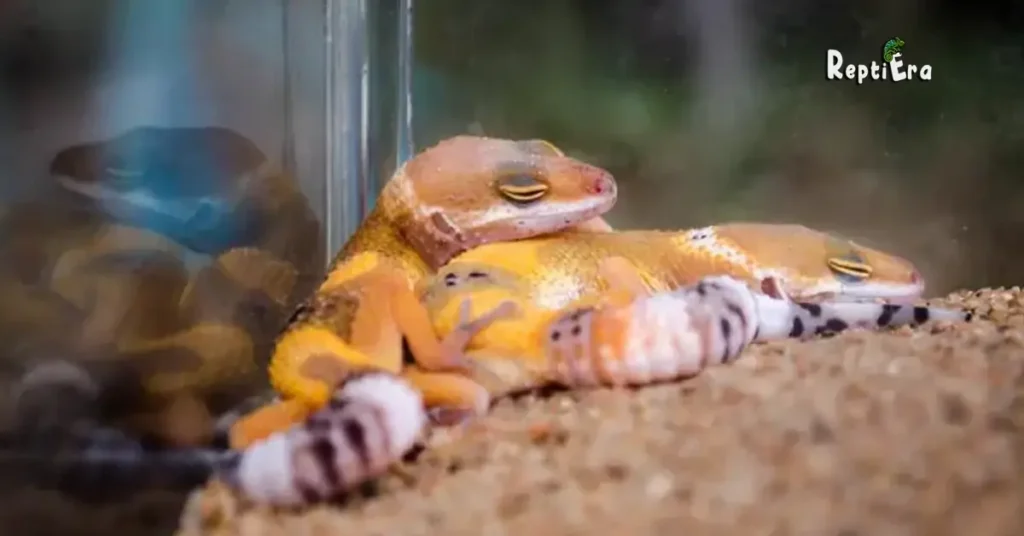
Considering introducing another creature to your leopard gecko’s habitat? Here are several key factors to ponder:
1. Living Conditions
No matter which animal you add to a leopard gecko’s tank, it’s crucial to assess their needs. While some needs may differ, finding animals with similar requirements ensures a harmonious environment. For instance, consider temperature and heat needs; space is also a key factor to determine if they are compatible. This is why crested geckos are not considered good tank mates for leopard geckos. Ideally, look for animals that thrive in the same desert climate that leopard geckos are accustomed to. Such a pairing leads to a great cohabiting experience, as both species are found to flourish under similar living conditions.
Related Post: CAN LEOPARD GECKOS LIVE TOGETHER
2. Competition
When you put animals that eat the same things together, competition can easily arise, sometimes leading to fighting over food. This can lead to violence or bullying among reptiles. A telltale sign to start paying attention is if you notice your leopard gecko drops its tail, a common stress response. Carefully consider this aspect before you decide to introduce another animal into your gecko’s environment. It’s essential to ensure that their dietary needs don’t overlap too much, reducing the risk of competitive behaviour.
3. Predation
Before you introduce another animal into your leopard gecko’s tank, it’s crucial to ensure that they won’t prey on the gecko. This is important when you opt for animals that don’t eat leopard geckos and aren’t significantly bigger than them. It’s a delicate balance to maintain a safe and harmonious environment in the tank, especially considering the natural instincts of different species. Choosing compatible tank mates is key to avoiding predation issues and ensuring the well-being of all inhabitants.
How Big Of A Tank Do You Need For Multiple Leopard Geckos?
Keeping multiple reptiles in a single enclosure requires careful planning. When picking up a tank at your local pet stores for your subsequent gecko, you’ll require the next size tank that’s appropriate for keeping multiple geckos together. If you plan to house geckos, you should add about five gallons to the size of the aquarium for each additional leopard gecko. This determines the need for space.
For example, I recommend a 10-gallon tank for a single baby and a 20-gallon tank for an adult. Adding a new reptile? Consider moving up to a 15-gallon or 25-gallon tank depending on their age. It’s always best to opt for a larger cage than you can afford to give them plenty of room to play, rest, and maintain their personal space, which is important. A larger enclosure also allows for a proper temperature gradient with a heat source and a cool hide.
Maintaining correct temperatures can be challenging in a larger enclosure, so you might need to put down an extra water dish with fresh water in multiple areas of the cage so they don’t have to travel far. It’s recommended to keep an extra enclosure to separate the geckos in an ideal situation where reptiles might fight or get injured.
Larger lizards can bully smaller ones, leading to weight loss, stress, and health issues. Having a spare enclosure at your disposal is helpful for these common situations, allowing you to nurse a gecko back to health without worrying about subsequent fights. For those setting up their first multi-gecko home, clicking on our website provides a comprehensive guide to help you through the process.
How to introduce another animal to your leopard gecko’s tank
Introducing a new creature into your leopard gecko’s habitat is a nuanced undertaking, typically entailing:
1. Preparing financially
Obviously, having more pets means more money to spend. When you decide to get another pet to accompany your leopard gecko, it’s essential to ensure you have a solid plan to pay for their food, lighting, heating, and overall care. This financial preparation is a crucial aspect of responsible pet ownership. It’s not just about the initial cost of the pet but also the long-term expenses that come with maintaining a healthy and comfortable environment for them. Being financially prepared ensures that all your pets receive the best possible care.
2. Quarantining the animals
Before you introduce any animal into your leopard gecko’s tank, it is advisable to take them through thorough health checks and quarantine them for at least one month. This is the only way to ensure that the new companion doesn’t carry diseases or parasites that could be transmitted to your gecko. After all, geckos are more susceptible to infections when under stress from being introduced to a new animal. Quarantining helps in safeguarding the health of all animals involved and ensures a smoother transition to their shared living space.
3. Monitoring the animals’ personalities
Before you put a new animal with your leopard gecko, it’s necessary to monitor their personality to see if they’re compatible with your pet’s temperament. It’s important to take time in choosing the right companion. You might go to a breeder and regularly keep an eye on the potential addition to your pet family.
Observing how they interact with others and their general behaviour gives valuable insight into whether they’ll be a good fit for your leopard gecko. Personality compatibility plays a crucial role in ensuring a harmonious and stress-free environment for all your pets.
4. The Food Chain In Action
If you want to observe the food chain in action with living creatures in tanks shared with a leopard gecko, I suggest staying within the lines of typical feeder insects like crickets, mealworms, and dubia roaches. These are the ideal types of prey that a leopard gecko will eat.
When they are placed in the enclosure during feeding time, it’s best if they are kept in a feeding dish designed to not allow escape. This setup provides a controlled environment for your leopard gecko to hunt and feed, ensuring their natural instincts are satisfied without the risk of feeder insects escaping and becoming a nuisance in the tank. ( designed so they do not escape.)
Related Post: HOW MUCH TO FEED LEOPARD GECKO
What about other leopard geckos?
Leopard geckos are fundamentally solitary creatures and it’s best if they are housed alone. Males, in particular, are territorial and likely to fight among themselves once they reach full size. While females can sometimes cohabitate, especially for breeding purposes, this arrangement should be approached with caution. For those interested in housing multiple leopard geckos together, I recommend you read further posts on our website that delve deeper into the intricacies and considerations of such a setup.
What Are The Benefits Of Keeping A Leopard Gecko Alone?
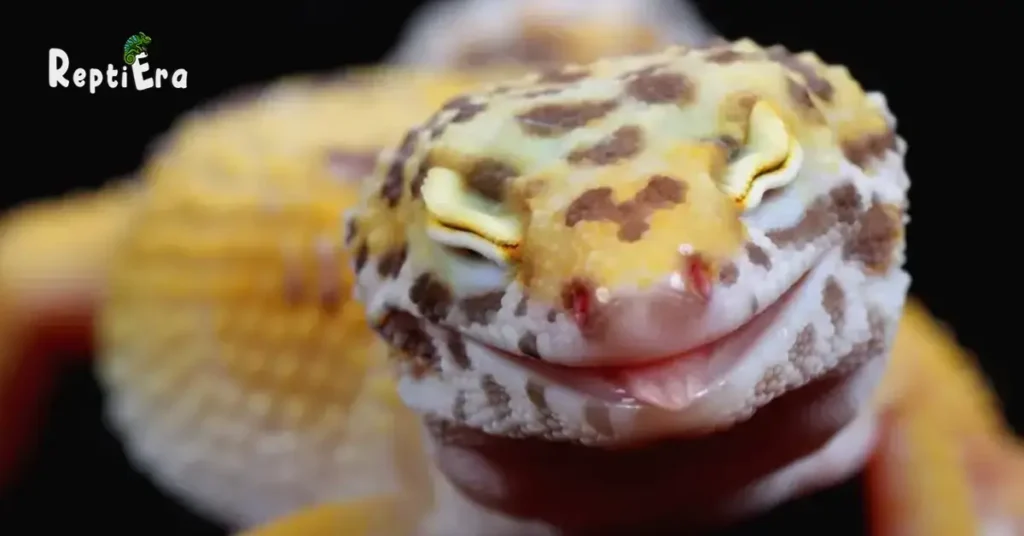
The truth is, keeping a leopard gecko without other animals in the terrarium has its inherent benefits. While it’s possible to introduce companions, it’s often risky without careful monitoring to ensure that both animals’ needs are met. A solo gecko doesn’t require adjustments for correct temperature settings or additions like heat rocks and heat lamps to cater to another species.
Note: Leopard geckos are relatively low-maintenance compared to other pets and maintaining them in the same environment alone simplifies care. The solitary setting allows your leopard gecko to thrive without the stress of sharing its space, making it an ideal choice for those seeking a straightforward and rewarding reptile-keeping experience.
The first reason to keep your leopard gecko alone is to better monitor their health.
One compelling reason to keep your leopard gecko alone is the ability to know exactly what goes on in your life without any interference. When a gecko eats, goes to the bathroom, or how leaves their insects, it’s much easier to be sure when there’s only one. With no concerns about one reptile being bullied out of a meal by someone else, you have a clear picture of their health and habits. This straightforward approach eliminates the question of whether your pet is thriving, ensuring that it receives the appropriate care and attention it needs in a stress-free environment.
You also never have to worry about fighting.
Having a solitary leopard gecko means you never have to worry about tense fighting between geckos, which can be potentially life-threatening and cause harm to your beloved pets. This peace of mind helps prevent the stress of taking an injured reptile to a veterinarian who specializes in exotics, which can be an expensive endeavour.
Balancing the needs of more than one animal in the same enclosure can be extraordinarily difficult. Each reptile might require different things, like a moist hide or specific UV lights. However, a single leopard gecko needs little to be happy and content; a simple paper towel as substrate and ensuring the temperature gradient is right is often enough.
Despite what some might believe, leopard geckos are not necessarily social creatures. They tend to be quite solitary, and they are not missing out on anything by being alone. Trying to match the right type of animal as a companion can be a challenge, if not an impossibility. Keeping a leopard gecko solo allows you to focus solely on their needs, creating a stress-free environment for both you and your pet.
Also Read: WHY IS MY LEOPARD GECKO ALWAYS HIDING
Selecting Leopard Gecko Tank Mates
Caring for leopard geckos involves not just providing a suitable enclosure, but also considering the compatibility of tank mates. It’s crucial to understand the potential risks of cohabitation since these reptiles are solitary creatures by nature. As a reptile enthusiast, my top priority is the well-being of these fascinating animals. Through this guide, we’ve explored the intricacies of their needs and suggested compatible companions that can help create a harmonious and safe environment for your beloved leopard gecko.
FAQs
What can you mix with a leopard gecko?
To create your substrate mix for Leopard Geckos, combine 40% organic topsoil with 20% sand and 20% excavator clay. Saturate this mixture, mix well, then add to the enclosure and allow it to dry before reintroducing the animal, to avoid illnesses related to high humidity.
What else can I put in my leopard gecko tank?
For your leopard gecko tank, pretty basic stuff is important: you’ll need an under-tank heating pad, a probe thermometer, two hiding places, a water dish, and a small dish for calcium. Use reptile carpeting or, as a similar last point, some owners prefer tile or paper towels; excavator clay can also be a good option.
Are leopard geckos OK to live alone?
Generally, due to their fairly solitary nature, leopard geckos are quite content to live alone. They can be kept in a group with either a single male and several females, or just females, but males should never be housed together due to aggressive behaviours.
Can A Leopard Gecko Live With A Bearded Dragon?
Leopard geckos and bearded dragons are not a great match for cohabitation due to their different husbandry needs, active times, and diet. Bearded dragons are omnivores and might be interested in the same food items, which can lead to conflict. While they are active during the day, early morning, and evening, leopard geckos are nocturnal, making them not ideal tank mates, especially in a very large enclosure. The significant size difference between the species may result in the leopard gecko getting beat up by the beardie, so while they might be possible friends outside the enclosure, they don’t make great tank mates.
Can Crested Geckos and Leopard Geckos Live Together?
Even though both are geckos, crested geckos and leopard geckos are likely to fight if they live in the same enclosure. Additionally, crested geckos are arboreal and nocturnal, having a different set of needs compared to the crepuscular, terrestrial leopard geckos.
Should you keep your leopard gecko alone?
Leopard geckos are generally solitary animals and tend to thrive when housed alone; so, don’t worry about them getting bored – they’re fine on their own.
Can Leopard Geckos Live With Other Lizards?
Once you have a lizard, many owners wonder if they can maintain them in an enclosure with other species. It’s tempting to expand your reptile knowledge and collection, but keeping them together isn’t always convenient. You might be surprised to learn that leopard geckos do not make great tank mates with the most popular choices available in pet stores, as they come from drastically different regions.
Can Leopard Geckos Live With Turtles?
While keeping a leopard gecko with other lizards is often a bad idea, some owners are tempted to house them with other species of animals. Turtles, being a common choice that many people turn to due to their peaceful and friendly nature, might seem like suitable companions, but their size and different habitat needs in a combined terrarium typically prohibit them from being good companions for leopard geckos.
Can Leopard Geckos Be Kept With Frogs?
If you’re determined to keep your gecko with a friend, considering frogs as a solution is tricky. There are many different types of frogs to choose from, but you’ll need to do your homework before heading out to a reputable breeder, as frogs are generally not compatible with other lizards. The best thing to do is to find a diurnal frog, meaning one that is awake during the day and asleep at night, to minimize stress on both animals.
Conclusion
In conclusion, when exploring the question of “What Can Live With A Leopard Gecko,” it becomes evident that leopard geckos are best suited to solitary living due to their specific needs and solitary nature. While it’s tempting to add a variety of tank mates, such as turtles, frogs, or even other lizards, these combinations often present significant challenges in terms of compatibility, space, and care requirements. The risks associated with mixing species, from territorial disputes to different habitat needs, highlight the importance of thorough research and consideration. Ultimately, leopard geckos thrive in environments tailored to their unique needs, emphasizing that, in many cases, they are happiest when housed alone, ensuring their safety and well-being.
